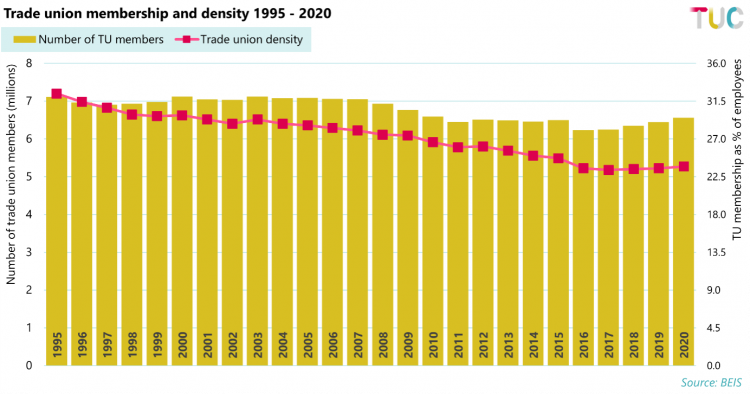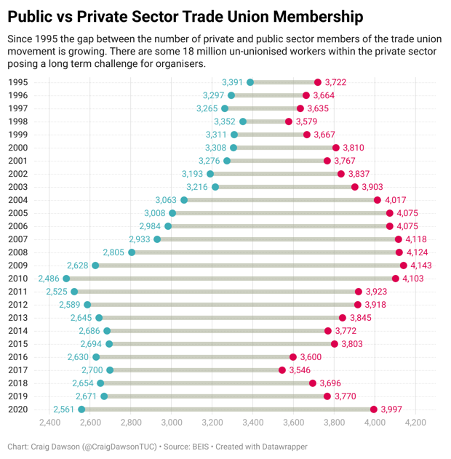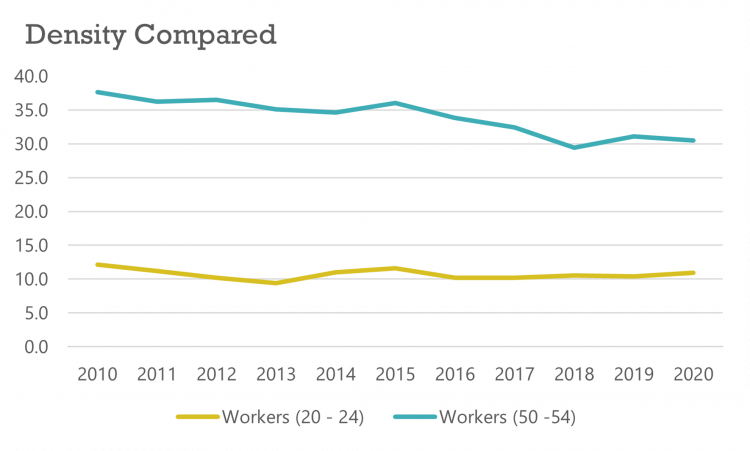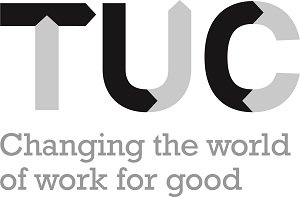Good news, bad news and the same challenges - trade union membership statistics
So first the good news.
Between 2019 and 2020 trade union membership increased by over 100,000, the fourth consecutive year in which it has risen. The last time that happened was the late 70s. This increase was propelled by a massive increase in the number of trade union members in the public sector of over 200,000. Almost 150,000 of these new members were employed in education.

Union density, the proportion of employees who are members of unions, also increased and now stands at 23.7%. There are now more women members of trade unions than at any point since 1995 - over 3.7 million women employees now carry a union card.
Now the bad news.
Union membership in the private sector fell by more than 100,000. This is the lowest level of membership in the private sector recorded since 1995. This fall reflects a fall in the total number of employees in the private sector of over 300,000, most likely caused by the pandemic. The fall in union membership in manufacturing was particularly significant. It is estimated that unions lost 80,000 members in the sector.

It wasn’t all bad news in the private sector, and we should acknowledge the work of unions organising in arts and entertainment, accommodation and food services and retail, all parts of the sector in which union membership increased.
And the challenges.
Increasing union membership and density in the private sector has been the biggest organising challenge facing the trade union movement in Britain has for the last 30 years, so the loss of 100,000 members in a sector where there are already around 18 million non-members is a big setback.
Yesterday’s news that the GMB union has reach a recognition agreement with Uber demonstrates that increasing union membership and organisation in a sector, where for many workers the relationship between themselves and their employer is becoming increasingly opaque, it’s not an impossible job. But the challenge is how unions can organise to scale.
It would be reasonable to assume that many of the hundred thousand members we have lost over the last year, were workers who found themselves furloughed on reduced pay because of the pandemic. Under the circumstances it would be understandable if many of them, when reviewing their monthly direct debits, decided to cancel their union membership subscription.
So, the first immediate challenge identified by the statistics is to re-recruit as many of these workers as possible. Not easy, but not impossible either. They are workers who have recently been in union membership and to whom it should be easier to make the case for the benefits of trade unions. Indeed, it was because of trade unions and the TUC that the furlough scheme was introduced in the first place, and whilst not perfect it undoubtedly saved many tens of thousands of jobs.
The second strategic challenge re-confirmed by the statistics is how we renew the trade union movement by dramatically increasing membership amongst young workers. Less than one in ten workers aged 16 to 24 are union members, and amongst union members themselves less than one in twenty are 16 to 24. Almost 40% of current union members are aged 50 or older. At the moment the trade union movement is not recruiting enough younger members to replace the ones we will lose through retirement over the next 10 to 15 years.

The key to addressing this challenge is to dramatically increase organising activity and membership in sectors such as hospitality, where there are large numbers of young workers, but where union density is just 4%.
What shouldn’t be in doubt is the commitment of the movement to address these challenges. Last summer the TUC General Council and the General Secretaries of all TUC affiliates signed up to the TUC Organising Pledge.
The pledge commits the movement to addressing the following six strategic challenges:
-
Increasing the number of workers aged under 30 in our movement.
-
Enthusing thousands of activists from all backgrounds to become new workplace reps, offering them training within the first six months and training every new rep within their first year.
-
Working co-operatively as TUC unions to bring trade unionism into new and growing sectors
-
Working jointly to eliminate insecure employment, including agreeing and pushing common bargaining agendas across sectors
-
Modernising how unions operate, organise and communicate for a digital-first era.
-
Driving up union membership in workplaces where we already have recognition agreements with employers
Unions will report progress against each of these challenges this July and then every year afterwards.
This will help us build on our successes and address the core issues facing the movement.
Stay Updated
Want to hear about our latest news and blogs?
Sign up now to get it straight to your inbox

